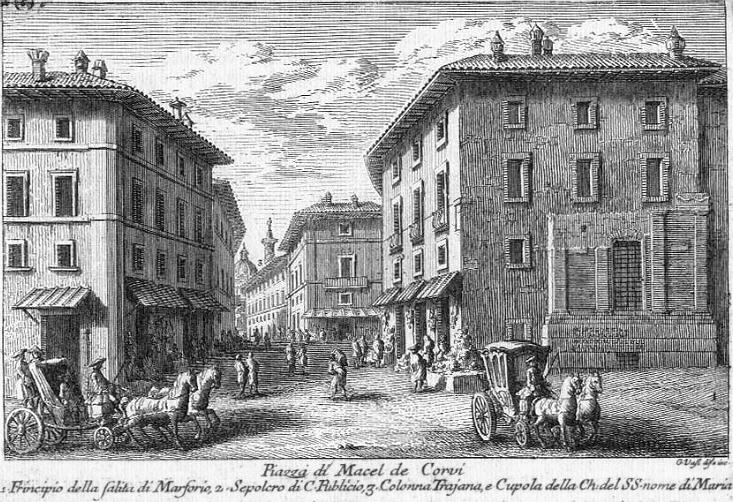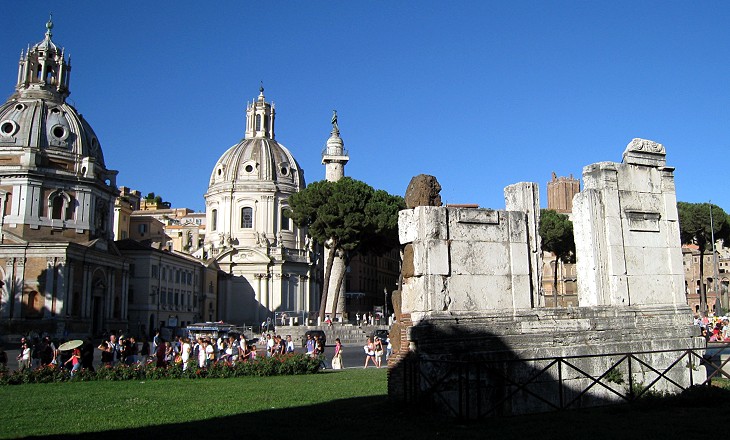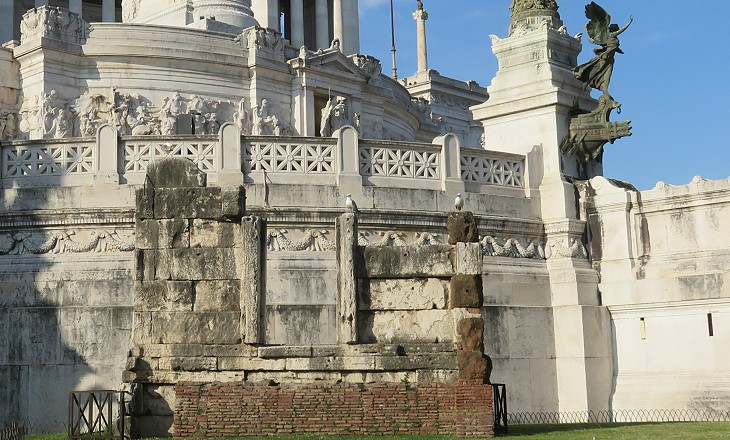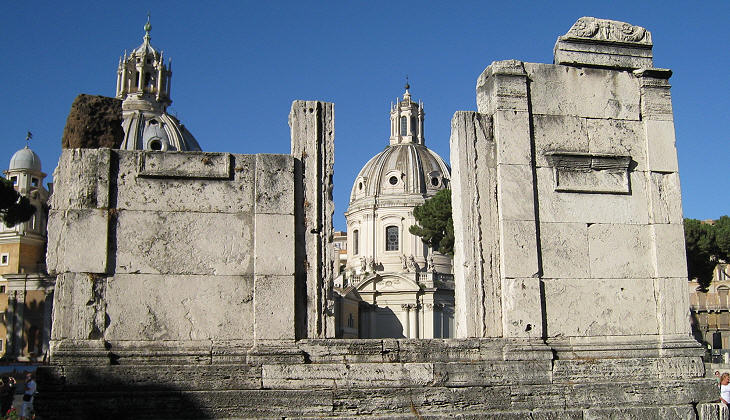Piazza di Macel de' Corvi (original) (raw)
 Piazza di Macel de' Corvi
(Vasi at work in the Grand View of Rome)
Piazza di Macel de' Corvi
(Vasi at work in the Grand View of Rome)
Links to this page can be found in Book 2, Day 3 and Rione Monti.
The page covers: [The plate by Giuseppe Vasi](#The Plate) Today's view [Sepolcro di Caio Publicio Bibulo](#The Tomb of Caio Publicio)
#### The Plate (No. 36 - ii)

In 1752 Giuseppe Vasi included the slight widening of a street in his second book of etchings which was meant to show the "Main Squares with Obelisks, Columns and other Embellishments". Maybe he was puzzled by the name of the site and he wanted to show his erudition by reporting some of the explanations for it. Macel de' Corvi literally means Slaughterhouse of the Ravens; according to Vasi, during the siege of Rome laid by the Gauls in 390 BC, a raven (Lat. corvus) helped a Roman warrior in a fight with a Gaul; in memory of his unexpected ally, the warrior added Corvinus to his name and he wanted to be portrayed in a statue with a raven on his helm in the location where the fight took place. The reference to the slaughterhouse was most likely due to the meat which was sold in the shops of this neighbourhood. The view is taken from the green dot in the 1748 map here below. In the description below the plate Vasi made reference to: 1) Salita di Marforio. This street linked [Piazza Venezia](Vasi65.htm#The Plate) with the top of [Campidoglio](Vasi80.htm#The Plate); Marforio, a talking statue, stood there until 1595 when it was moved to Piazza del Campidoglio; 2) Tomb of Caio Publicio Bibulo; 3) Colonna Trajana and Dome of SS. Nome di Maria. 3) is shown in more detail in another page. The small map shows also 4) Piazza di Macel de' Corvi. The dotted line in the small map delineates the borders between Rione Pigna (upper left quarter), Rione Trevi (upper right quarter), Rione Campitelli (lower left quarter) and Rione Monti (lower right quarter).

#### Today

## The view in August 2008
Macel de' Corvi does not exist any longer and now Colonna Trajana and SS. Nome di Maria are in full view. The construction of [Monumento a Vittorio Emanuele II](Vasi65.htm#Monument to Victor Emmanuel) (late XIXth century) and the opening of Via dei Fori Imperiali, a large avenue leading to Colosseo (1932) required a toll to be paid and this neighbourhood which did not have famous churches and palaces was completely pulled down, with the sole exception of the tomb of Caio Publicio Bibulo.

## The tomb of Caio Publicio Bibulo and behind it the lower part of Monumento a Vittorio Emanuele II
#### Sepolcro di Caio Publicio Bibulo

## Remaining side of the tomb of Caio Publicio Bibulo; it is thought that what today seems a window was originally a niche housing a statue of Bibulo
Ancient Romans were not allowed to be buried inside the walls and the tomb of Caio Publicio Bibulo seems to contradict this statement, yet when the monument was erected (Ist century BC), the area at the foot of Campidoglio was not included in the pomerium, the sacred boundary of the City of Rome. It probably stood outside Porta Fontinalis, a lost Roman gate at the end of Clivus Argentarius, probably near the shop of C. Julius Helius, a shoemaker who is mentioned in a very interesting stela.

## (left) Inscription in the lower part of the remaining (southern) side of the tomb; (right) fragment of the same inscription on the eastern side of the tomb
The inscription:
## C(aio) Poplicio Bibulo Aed(ili) Pl(ebis) honoris virtutisque caussa Senatus consulto populique iussu locus monumento quo ipse posterique eius inferrentur publice datus est
says that the monument was paid for by the Senate in recognition of the services provided by Caio Publicio Bibulo; in the lack of other historic references to him, the decision by the Senate is rather puzzling because "Aedile of the People", the only office held by Caio Publicio Bibulo, was a minor one in the political structure of the Roman Republic. The inscription was repeated on all four sides of the monument, the use of which was granted to Bibulo's heirs forever. The image used as background for this page is based on a 1756 etching by Giovan Battista Piranesi.
Next plate in Book 2: [Piazza alli Monti](Vasi37.htm#The Plate). Next step in Day 3 itinerary: [Chiesa e Monastero dello Spirito Santo](Vasi142.htm#The Plate). Next step in your tour of Rione Monti: [Chiesa e Monastero dello Spirito Santo](Vasi142.htm#The Plate).
Excerpts from Giuseppe Vasi 1761 Itinerary related to this page:
###### Macel de' Corvi
##### Qu� sebbene non vi sia, che una piccolissima piazza, con tutto ci� evvi un abbondante mercato di tutte le sorte di viveri. E' notabile il sepolcro di Cajo Publicio, che si vede nell'angolo della salita, che dicesi di Marforio, con una antica iscrizione, che resta quasi perduta.